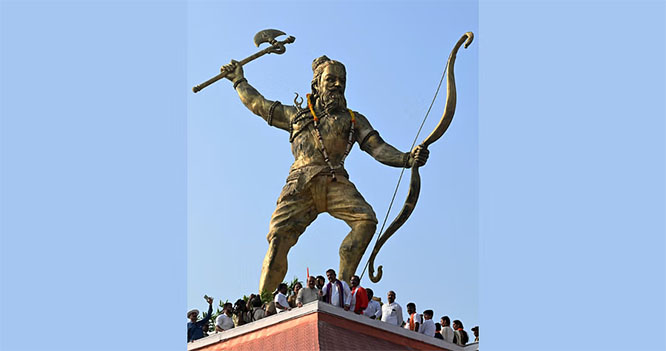
Kochi, Sept 2: Prime Minister Narendra Modi on Friday commissioned the first indigenously designed and built aircraft carrier INS Vikrant at Cochin Shipyard Limited in Kochi. PM Modi Modi received the Guard of Honour as he arrived for the Commissioning ceremony of INS Vikrant in Kerala.
He then unveiled the new Naval Ensign (Nishaan), doing away with the colonial past on the occasion. Naval Ensigns are flags that naval ships or formations bear to denote nationality. The current Indian Naval Ensign consists of a St. George's Cross -- a red cross with white background.
In one corner of the cross, the Indian flag was put when the country attained freedom, replacing the Union Jack in that place.
Modi has described September 2 as a "landmark day for India's efforts to become Aatmanirbhar in the defence sector" as the first indigenously designed and built aircraft carrier has been commissioned.
A host of dignitaries including Defence Minister Rajnath, Shipping Minister Sarbananda Sonowal, Governor Arif Mohamad Khan, Chief Minister Pinarayi Vijayan, Ernakulam MP Hibi Eden, Navy Chief Admiral R Hari Kumar and top officials of Navy and Cochin Shipyard Limited (CSL) attended the event.
Designed by the Indian Navy's in-house Warship Design Bureau (WDB) and built by Cochin Shipyard Limited, Vikrant has been built with state-of-the-art automation features.
It has a large amount of indigenous equipment and machinery, involving major industrial houses in the country- BEL, BHEL, GRSE, Keltron, Kirloskar, Larsen & Toubro, Wartsila India etc. as well as over 100 MSMEs. With the commissioning of Vikrant, India will have two operational aircraft carriers, which will bolster the maritime security of the nation.
The Indigenous Aircraft Carrier (IAC) is named after her illustrious predecessor, India's first aircraft carrier, which had played a vital role in the 1971 war.
As per the Indian Navy, the 262-meter-long carrier has a full displacement of close to 45,000 tonnes which is much larger and more advanced than her predecessor.
With Vikrant, India has joined a select group of nations (the US, Russia, France, the UK and China) having the niche capability to indigenously design and build an aircraft carrier.
IAC Vikrant consists of 14 decks with 2,300 compartments that can carry around 1,500 sea warriors and to cater to the food requirements, around 10,000 chapatis or rotis are made in the ship's kitchen, which is called the ship's galley.
The ship is powered by four Gas Turbines totalling 88 MW power and has a maximum speed of 28 Knots. Built at an overall cost of close to ₹20,000 crores, the project has been progressed in three Phases of the contract between MoD and CSL, concluded in May 2007, December 2014 and October 2019 respectively. The ship's keel was laid in Feb 2009, followed by launching in August 2013.
The ship would be capable of operating an air wing consisting of 30 aircraft comprising of MIG-29K fighter jets, Kamov-31, MH-60R multi-role helicopters, in addition to indigenously manufactured Advanced Light Helicopters (ALH) and Light Combat Aircraft (LCA) (Navy).
INS Vikrant history
INS Vikrant began her journey as the HMS Hercules, an aircraft carrier in the (British) Royal Navy in 1943 during the second world war. But it remained incomplete as the war ended, and in 1946, the work on the ship was suspended.
After the war, the UK and US navies wanted to sell the ships they no longer needed. So, in 1957, the Indian government purchased HMS Hercules. It became INS Vikrant when it was commissioned into the Indian Navy on 4 March 1961 in Belfast. The name Vikrant was derived from the Sanskrit word 'Vikranta', meaning 'Very powerful' and 'brave'. The ship formally joined Indian Navy in the Bombay harbour on 3 November 1961 and was received by then PM Jawaharlal Nehru at Ballar Pier.
The ship played an active role during the liberation of the Bangladesh war, in 1971. The aircraft carrier remained in service for another 26 years, till she was decommissioned on 31 January 1997. The Vikrant was then converted into a museum ship and remained berthed in Bombay harbour, open to the public to marvel at her glorious past. Due to rising maintenance costs and poor conditions, the Vikran ship was finally scrapped in November 2014.







Comments
Add new comment